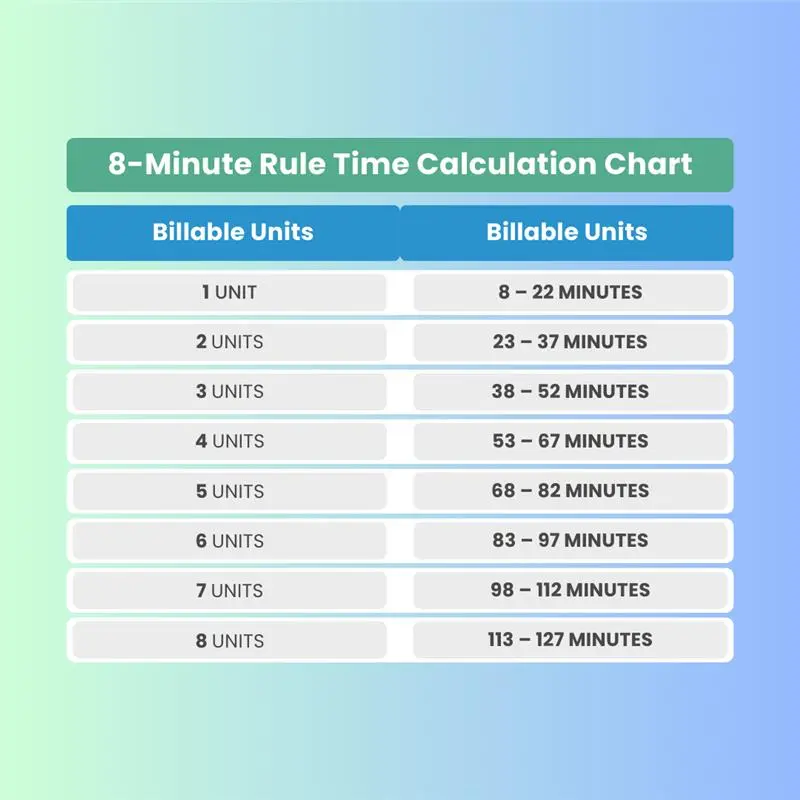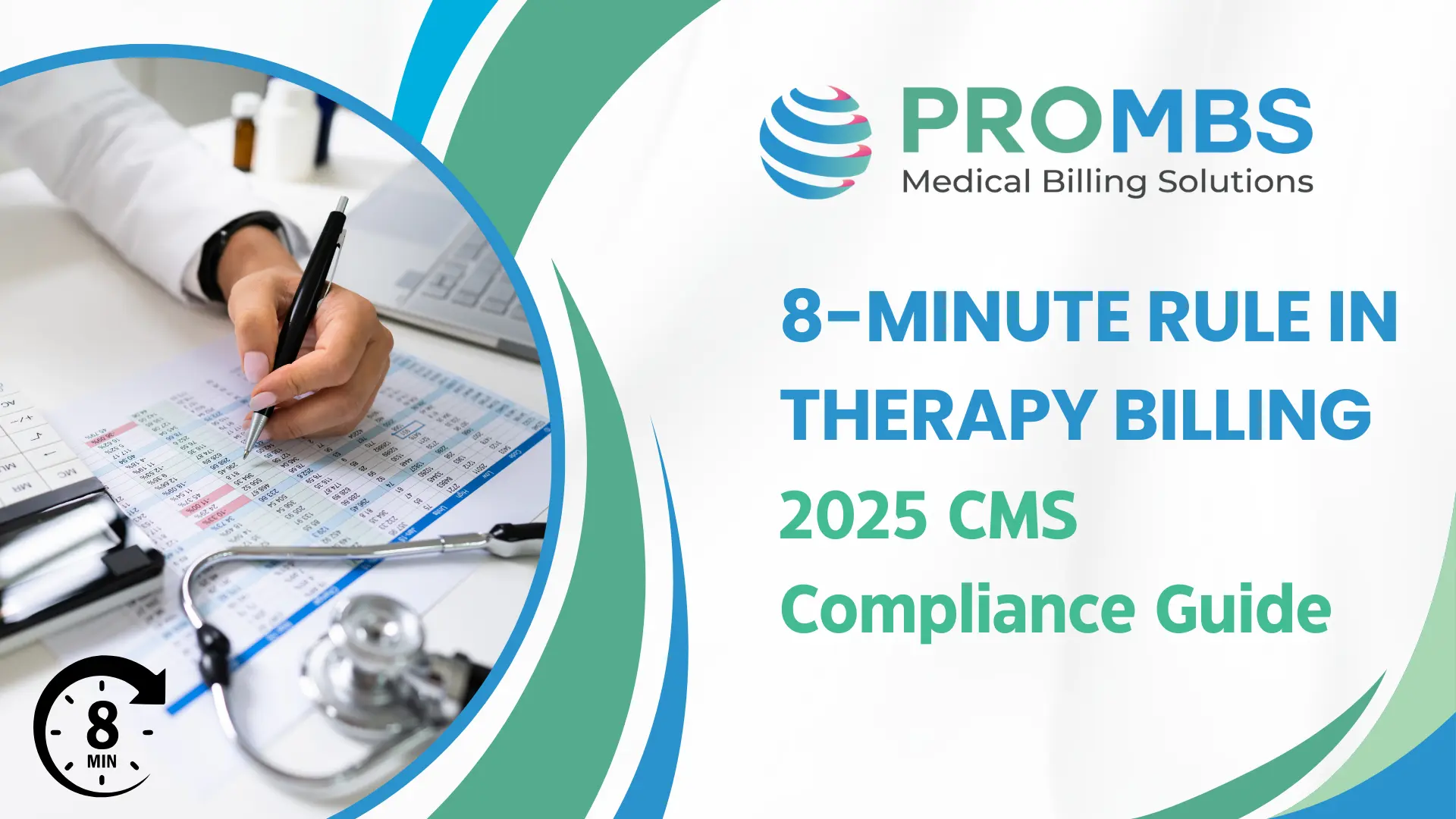When it comes to physical therapy, occupational therapy, and speech therapy billing, few rules cause as much confusion as the 8-minute rule. For providers, coders, and billers, knowing how this rule works is crucial to ensure accurate claim submission, prevent denials, and maintain compliance with CMS guidelines. Let’s break it down clearly and technically so you can apply it with confidence in your daily billing practice.
What Is the 8-Minute Rule?
The 8-minute rule is a guideline established by the Centers for Medicare & Medicaid Services (CMS) to determine how time-based CPT codes should be billed for outpatient therapy services. Simply put, it dictates the minimum amount of time a provider must spend delivering a service to bill for one time-based unit.
If at least 8 minutes of a service are provided, you may bill for one unit of that service. Anything less than 8 minutes cannot be billed.
Why Was the 8-Minute Rule Created?
The 8-minute rule ensures fairness and consistency in reporting time-based therapy services. Without it, providers might bill for entire units even if they only delivered a few minutes of care, leading to overbilling. This rule creates a standardized system so that claims accurately reflect the actual time spent with patients.
How the 8-Minute Rule Works in Practice
The 8-minute rule determines how many billable units you can claim based on the total time spent delivering a time-based therapy service. Instead of rounding to the nearest 15 minutes, CMS requires you to meet a minimum threshold of 8 minutes before billing one unit. From there, each additional unit has its own time range.
Think of it as a cumulative system: you add up the total one-on-one therapy time and then match it to the unit thresholds. This prevents overbilling for shorter encounters while ensuring fair reimbursement for extended therapy sessions.
For example, if a therapist spends 22 minutes on therapeutic exercise (CPT 97110), only one unit can be billed, since it does not cross the 23-minute threshold for 2 units. If the session lasted 25 minutes, then 2 units would be billable.

Time-Based vs. Service-Based Code
In therapy billing, CPT codes are generally categorized into two groups: time-based and service-based. Understanding this distinction is critical when applying the 8-minute rule because it only applies to time-based codes, not service-based ones.
Time-Based Codes
These codes are billed according to the actual minutes of direct, face-to-face treatment provided to the patient. Each unit typically represents 15 minutes of therapy. The 8-minute rule determines how many units can be billed based on the documented time.
Examples of time-based codes:
- 97110 – Therapeutic exercise, per 15 minutes
- 97140 – Manual therapy techniques, per 15 minutes
- 97112 – Neuromuscular re-education, per 15 minutes
- 97530 – Therapeutic activities, per 15 minutes
Service-Based Codes (Untimed Codes)
These codes are billed once per encounter or session, regardless of how much time is spent delivering the service. They represent services that are not tied to minutes but to the performance of the activity itself.
Examples of service-based codes:
- 97161–97163 – Physical therapy evaluations (low, moderate, high complexity)
- 97164 – Re-evaluation of a PT plan of care
- 97010 – Application of hot/cold packs
- 97014 (G0283) – Electrical stimulation (unattended)
The 8-Minute Rule vs. the Substantial Portion Rule
| Rule | Definition | Billing Threshold | Commonly Used By |
|---|---|---|---|
| 8-Minute Rule | CMS guideline that requires at least 8 minutes of a 15-minute timed service to bill 1 unit. | 1 unit = 8–22 minutes (then follow incremental ranges). | Medicare and Medicare Advantage plans |
| Substantial Portion Rule | Requires at least 50% of the defined time for a CPT code to be billed. Often used by some commercial payers. | 1 unit = ≥ 7.5 minutes of a 15-minute code. | Some commercial/private payers |
Common Mistakes in Applying the 8-Minute Rule
1. Rounding Incorrectly
Some providers mistakenly round up short treatment times. For example, if only 6 minutes of manual therapy (CPT 97140) were performed, billing one unit would be incorrect under the 8-minute rule. Medicare strictly requires a minimum of 8 minutes before a unit is billable. Anything less must be considered non-billable, even if it feels close enough.
2. Mixing Time Across Different Codes
Another common mistake is combining minutes from different CPT codes to reach the threshold for a unit. For instance, if a therapist performs 5 minutes of therapeutic exercise (97110) and 6 minutes of manual therapy (97140), those cannot be added together to bill a single unit. Each code must independently meet the minimum 8-minute requirement to be billed. Mixing times across codes is considered unbundling and can trigger claim denials or audits.
3. Not Documenting Clearly
Lack of precise documentation is one of the biggest red flags during audits. Notes like “patient seen for 30 minutes of therapy” are insufficient. Instead, providers must record:
- Start and stop times for each timed service.
- Exact minutes spent on each code.
- Details of the intervention performed and patient response.
Without this clarity, auditors may deny claims or recoup payments even if the services were provided correctly. Proper documentation ensures the billed units align with the 8-minute rule and stand up under scrutiny.
Documentation Best Practices
What to Document
- Start and stop times for each service
Record the exact minutes spent on each CPT code (e.g., Therapeutic Exercise: 10:05–10:25 = 20 minutes). This provides a transparent timeline that matches the billed units. - Type of activity performed
Specify whether the service was therapeutic exercise, manual therapy, neuromuscular re-education, or another billable code. Simply writing “therapy performed” is insufficient; payers require code-specific details. - Patient’s response and progress
Document measurable outcomes or observations, such as improved range of motion, decreased pain, or tolerance to activity. This shows medical necessity and strengthens your case if reviewed.
Why Documentation Matters
- Supports compliance: Auditors cross-check minutes and units billed against your notes.
- Prevents denials: Clear time-based documentation eliminates guesswork for payers.
- Protects providers: In case of an overpayment recovery request, detailed records demonstrate that billing was accurate and justified.
Why the 8-Minute Rule Matters for Compliance
The 8-minute rule is more than just a billing guideline, it is a compliance standard set by CMS. Incorrect application can create significant financial and legal risks for providers and billing organizations.
Risk of Denials and Repayments
Increased Audit Exposure
CMS and commercial payers use data analytics to flag unusual billing patterns, such as consistently billing maximum units without sufficient documentation. Misuse of the 8-minute rule can result in targeted audits, where every therapy claim is scrutinized. If discrepancies are found, this can lead to further investigations, penalties, or even exclusion from payer networks.
Protecting Providers Through Compliance
By applying the 8-minute rule correctly and documenting start/stop times, activity details, and patient response, providers can:
- Ensure accurate reimbursement for services performed.
- Demonstrate medical necessity and coding accuracy in case of audits.
- Maintain compliance with CMS and payer regulations, reducing legal and financial risks.
Conclusion
The 8-minute rule is not just a billing formula, it is a compliance framework that underpins the integrity of therapy claims. By distinguishing between time-based and service-based codes, adhering to the correct time thresholds, and maintaining precise documentation, providers can safeguard revenue while demonstrating adherence to CMS standards.
In medical billing and coding, mastery of the 8-minute rule ensures accurate unit calculation, prevents denials, and minimizes the risk of audit exposure. In today’s regulatory environment, compliance is inseparable from financial stability. Applying this rule correctly is therefore both a technical skill and a compliance necessity; one that every therapy billing team must consistently reinforce in daily practice.



